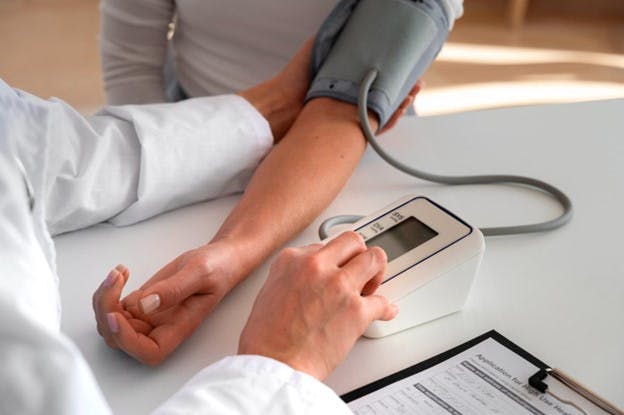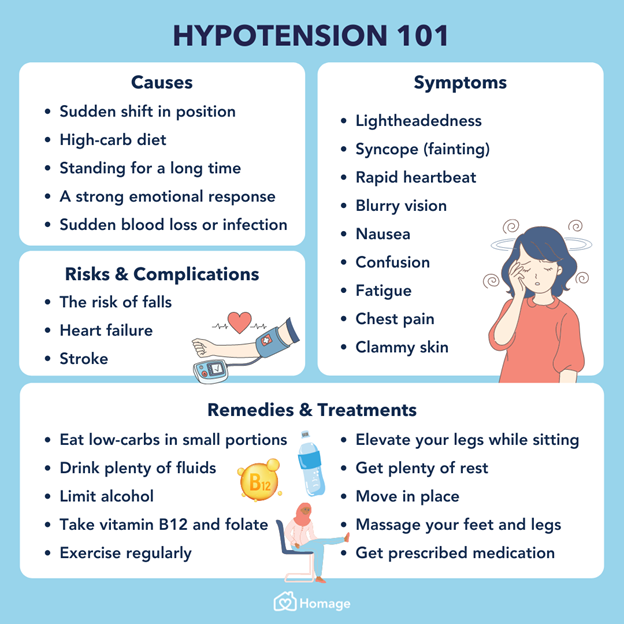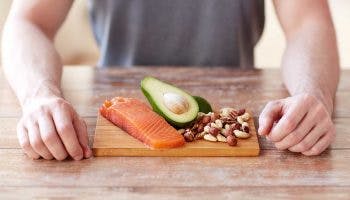Understanding Hypotension: All You Need to Know
Published | 7 min read

We’re all too familiar with the silent killer known as hypertension. But is its alter ego, hypotension, just as deadly? In this article, we look into everything you need to know about hypotension: types, causes, symptoms, risks and treatment.
What is hypotension?
Hypotension (low blood pressure) occurs when a person’s blood pressure drops to lower than normal, that is, 90/60 mmHg and below. The drop in blood pressure can make a person feel dizzy or lightheaded and increase the risk of falls, especially in older adults.
Fortunately, hypotension is not always a cause for concern when there are no symptoms, and therefore, does not need to be treated. However, it might lead to other health complications when there is inadequate blood flow to the heart, brain, and other vital organs. When this happens, you may need to seek treatment. Therefore, it is important to understand how hypotension might affect your body and what you can do to protect yourself.
Types Of Hypotension & Its Causes
First, let’s look at the types of hypotension. Different types of hypotension have different causes. The four major types and their causes are:
Orthostatic Hypotension
Orthostatic hypotension (or postural hypotension) happens when you suddenly change your position from sitting or lying down to standing. Gravity makes blood pool in the lower parts of your body, and consequently, less blood flows back to the heart.
Orthostatic hypotension makes one feel dizzy or lightheaded. In severe cases, it is associated with and can contribute to life-threatening heart problems. This is the most common form of hypotension affecting people of all ages, but it is more common in older adults.
Postprandial Hypotension
Postprandial hypotension is when the blood pressure is lowered after a meal, especially with a high-carbohydrate diet. This occurs because more blood flow is needed in the intestine to digest the food. Subsequently, less blood blows to other parts of the body causing the blood pressure to drop below normal.
Postprandial hypotension results in dizziness, faintness and falls. It’s most common in older adults and people with autonomic dysfunction.
Neurally Mediated Hypotension
Neurally mediated hypotension (NMH) occurs when the body has problems regulating blood pressure. This could be due to two reasons:
- Standing for a really long time.
- A strong emotional response to an upsetting or frightening situation.
NMH normally makes one lightheaded, but in severe cases, he or she might faint. It mostly affects young adults and children and can be outgrown.
Severe Hypotension
A sudden dip in blood pressure is referred to as severe hypotension. When an individual is faced with a serious injury, sudden loss of blood or infection, their blood pressure and blood flow plummet to perilously low levels.
Severely low levels of blood pressure deprive the vital organs of oxygen and the body goes into a shock. This results in something life-threatening if not treated.
Other causes
Other common factors can cause someone’s blood pressure to be lowered, including:
- Pregnancy
- Hormonal problems such as diabetes, hypothyroidism (underactive thyroid) or hypoglycemia (low blood sugar)
- Chronic heart conditions, heart failure or abnormal heart rhythms
- Dehydration and/or heat exhaustion
- A severe allergic reaction like anaphylaxis
- Certain medications, e.g. drugs for Parkinson’s disease, neuroleptics, anti-anxiety agents and hypertension drugs
Symptoms of Hypotension
When your vital organs are not receiving enough oxygen due to the low blood pressure, your body will start to feel unwell. Look out for these 10 signs or symptoms:
- Dizziness, unsteadiness or lightheadedness
- Weak pulse or rapid heartbeat
- Blurry vision
- Fainting or syncope (loss of consciousness)
- Chest pain
- Nausea
- Confusion
- Anxiety
- Fatigue
- Clammy skin (cooling effect from sweating)
Hypotension can also be asymptomatic, so worry not if you do not have any symptoms.
If you do experience any of the symptoms mentioned above, speak to your doctor about it. He or she may run some tests to learn the underlying cause and suggest ways to manage your blood pressure.
Must-Know Risks & Complications
Low blood pressure may come with some serious complications. However, this depends on what the symptoms are and what influences your low blood pressure.
Thus, take caution of the following risks:
- The risk of falls, often resulting from lightheadedness or fainting. This is a particularly prevalent issue among older people, especially those dealing with frailty. If you fall, you might end up injured with severe wounds, broken bones or a concussion.
-
- Here’s some advice on fall prevention to keep your elderlies safe and protected.
- Heart failure is also a potential complication associated with low blood pressure. What happens is the heart works a lot harder and faster to pump more blood to the rest of the body. If the heart overworks itself too often, you could be at risk of heart failure.
- Watch this video by one of our in-house nurses on how to care for your heart.
- Organ failure or stroke could occur due to shock. If your blood pressure drops to the point your body goes into shock, your organs will cease to function. If there is not enough blood supply to the brain, you may be at risk of stroke.
- Learn how to BE FAST when stroke strikes with this article.
Remedies & Treatment for Hypotension
There is little knowledge of how to prevent hypotension to this day. What you can do is monitor your blood pressure readings regularly and learn to better manage your blood pressure.
Here are 15 ways to raise your blood pressure with diet, exercise, habit changes, and medication:
Diet
- Eat low-carbohydrate meals in small portions. Limit high-carb ingredients (like potatoes, rice and pasta) and use healthier substitutes like brown rice, protein and spinach noodles.
- Drink plenty of fluids. To add to water’s many known health benefits, water is great for controlling blood pressure by increasing your blood volume and preventing dehydration.
- Drink caffeinated beverages in the morning like coffee and tea. It is known to effectively spike blood pressure, but the response differs from person to person. Avoid taking too much caffeine as it can cause dehydration.
- Limit your alcohol intake. Alcohol lowers blood pressure even with moderate consumption. Additionally, it can quickly dehydrate your body.
- Eat foods high in vitamin B12 (meat, cheese, yoghurt, eggs) and folate (broccoli, spinach, chickpeas).
- Increase your sodium intake by incorporating more salt into your diet. Do this with caution and if you are an older adult, this is not recommended.
Exercise
- Exercise regularly to help your body pump blood back to the heart. You can start slow with 30 minutes of light exercise for two or three days a week. Then, gradually increase the intensity at a moderate pace.
- Move in place. Standing for long periods can affect your blood pressure. Try sitting down and moving in place by stretching your hands and legs. If you need to stand up, do so slowly.
- Breathing exercises are a great way to stabilise blood pressure and reduce abnormally rapid breathing. Do this when you feel dizzy.
- Work out in well-ventilated spaces to allow your body to breathe more oxygen. Avoid hot, humid environments.
Pro tip: Remember, changing your positions suddenly can cause dizziness for those with postural hypotension. So, take your time and go slow. If you start to experience the symptoms, sit still, breathe and allow yourself to cool down until it passes.
Habit changes
- Get plenty of rest, but not too much rest. Prolonged bed rest or sitting can worsen your low blood pressure.
- Elevate your legs while sitting, don’t cross them. This helps the blood to move to your upper body.
- Keep track of your emotional or stress triggers. Is it a scary situation? Or something you ate? Learning what they are can help you to avoid placing yourself in those situations.
- Massage your feet and legs. Apply pressure to facilitate your blood circulation and push blood back to the heart. Compression socks could also help with this as well as reduce swelling.
Medication
- Get prescribed medication from the doctor if the natural remedies are relieving your symptoms. Midodrine and hydrocortisone are typically used to raise significantly low blood pressure.
Other considerations
Be sure to inform your doctor if you are already prescribed drugs for other conditions to avoid any unwanted drug interactions. Don’t quit taking the medications on your own but seek your doctor’s advice.
Download this quick info guide for easy reference and share it with someone to increase awareness of hypotension!

Are you looking for someone to care for your loved ones?
Homage is a personal healthcare solution that connects caregivers, nurses and therapists with seniors who need on-demand holistic home care in their homes, allowing them to recover and age with grace, control and dignity.
Download the app now to find out more and start booking quality care for your loved one!
References
- Jordan, J., Shannon, J. R., Black, B. K., Ali, Y., Farley, M., Costa, F., Diedrich, A., Robertson, R. M., Biaggioni, I. & Robertson, D. (2000). The Pressor Response to Water Drinking in Humans. American Heart Association Journals, 101, 504–509. https://doi.org/10.1161/01.CIR.101.5.504
- Moghaddam, M. (2020). How To Boost Your Circulation (And Why It’s Important!). Henry Ford. Retrieved from https://www.henryford.com/blog/2020/10/how-to-boost-circulation
- Roland, J. (2019). What Is Postprandial Hypotension. Healthline. Retrieved from https://www.healthline.com/health/postprandial-hypotension
- G. & Fedorowski A. (2021). Hypertension, hypotension and syncope. Minerva Med. doi: 10.23736/S0026-4806.21.07562-5
- Seladi-Schulman, J. (2019). What Are the Different Types of Syncope. Healthline. Retrieved from https://www.healthline.com/health/types-of-syncope
- (2021). In A.D.A.M. Medical Encyclopedia, MedlinePlus. Retrieved from https://medlineplus.gov/ency/article/000039.htm
- Thompson, A. D. (2020). Orthostatic Hypotension. Merck Manual Professional Version. Retrieved from https://www.merckmanuals.com/professional/cardiovascular-disorders/symptoms-of-cardiovascular-disorders/orthostatic-hypotension?qt=orthostatic%20hypotension&alt=sh
- Weil, R. (2017). Can I Still Exercise With Low Blood Pressure. Medicinenet. Retrieved from https://www.medicinenet.com/can_i_still_exercise_with_low_blood_pressure/ask.htm
- (2020). Diastole vs. Systole: Know Your Blood Pressure Numbers. Retrieved from https://www.webmd.com/hypertension-high-blood-pressure/guide/diastolic-and-systolic-blood-pressure-know-your-numbers
- American Heart Association. (2016). Low blood pressure – When blood pressure is too low. Retrieved from http://www.heart.org/HEARTORG/Conditions/HighBloodPressure/GettheFactsAboutHighBloodPressure/Low-Blood-Pressure—When-Blood-Pressure-Is-Too-Low_UCM_301785_Article.jsp#.WbYyGciGOM8
Share this article on






